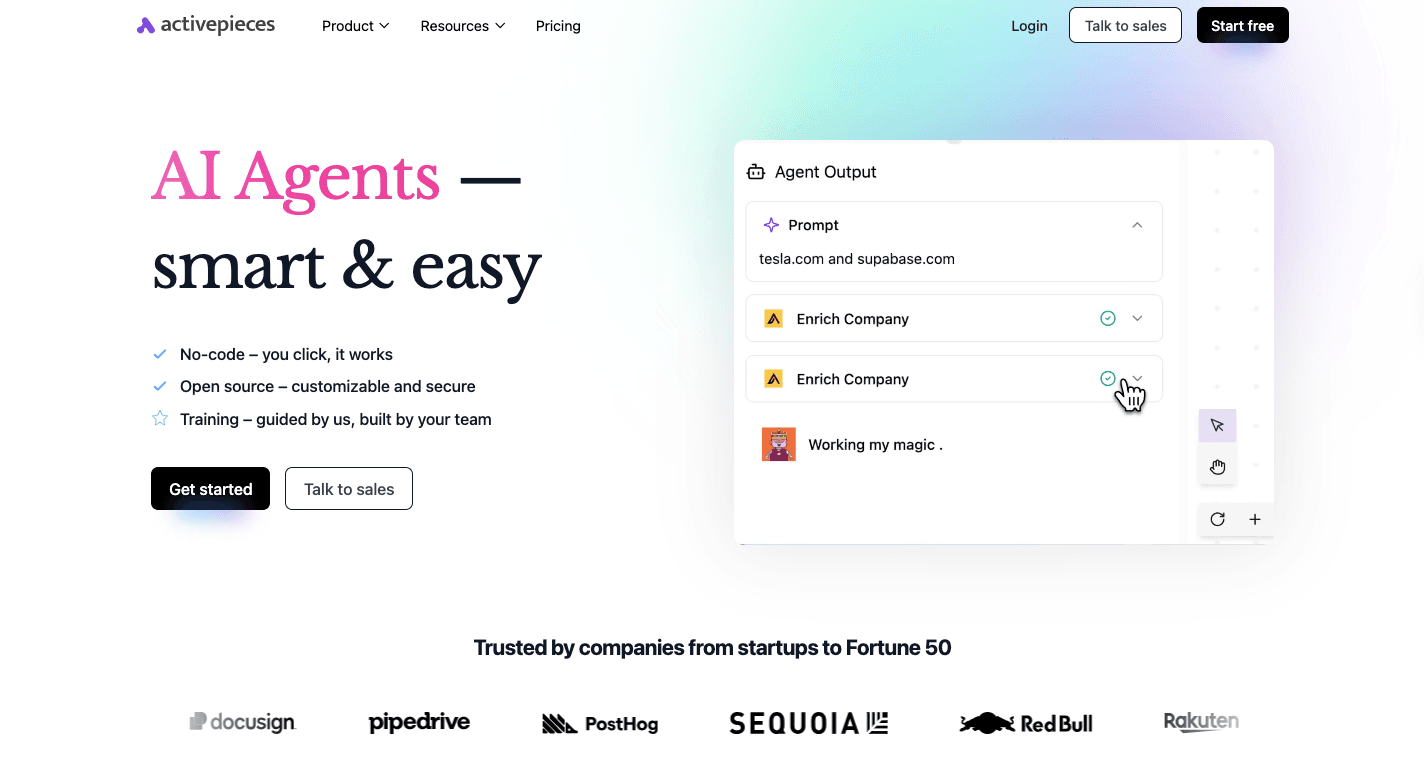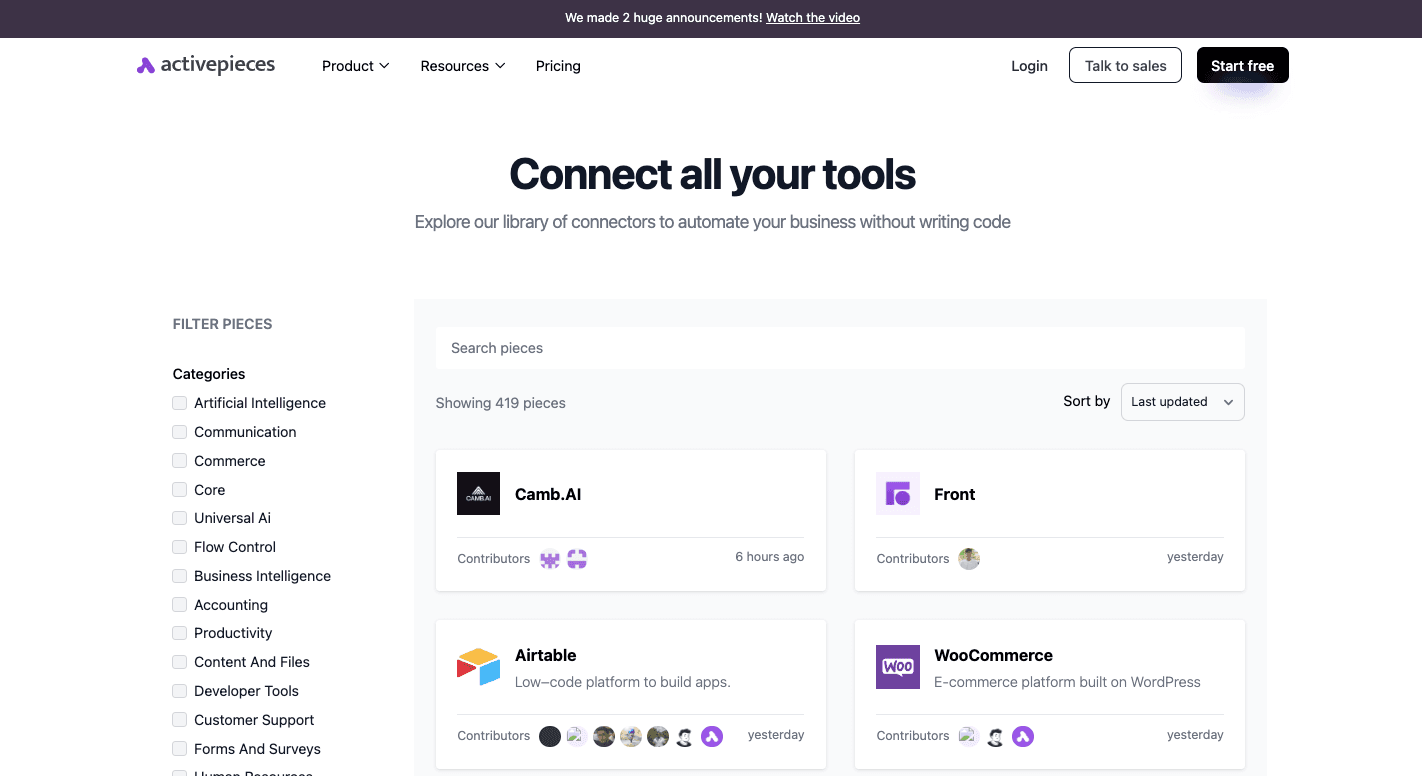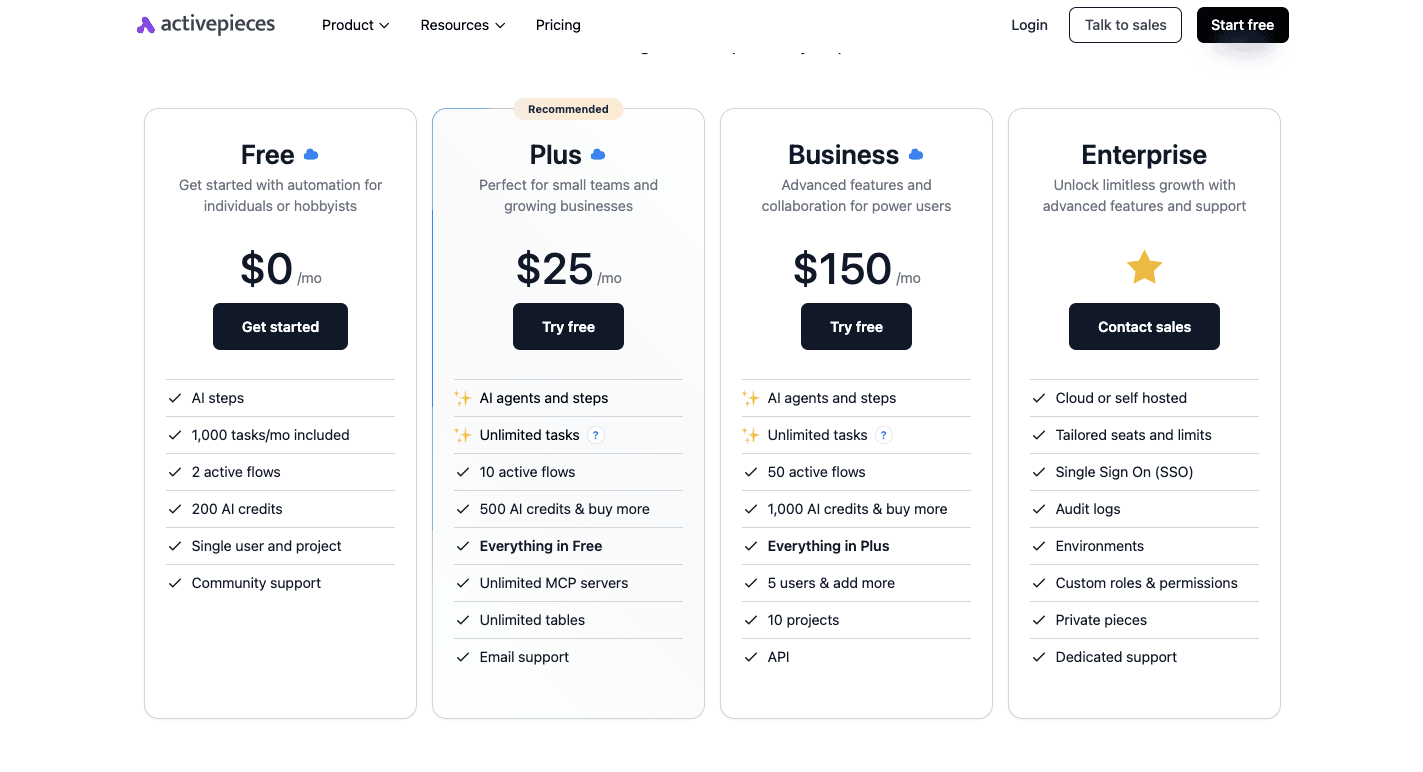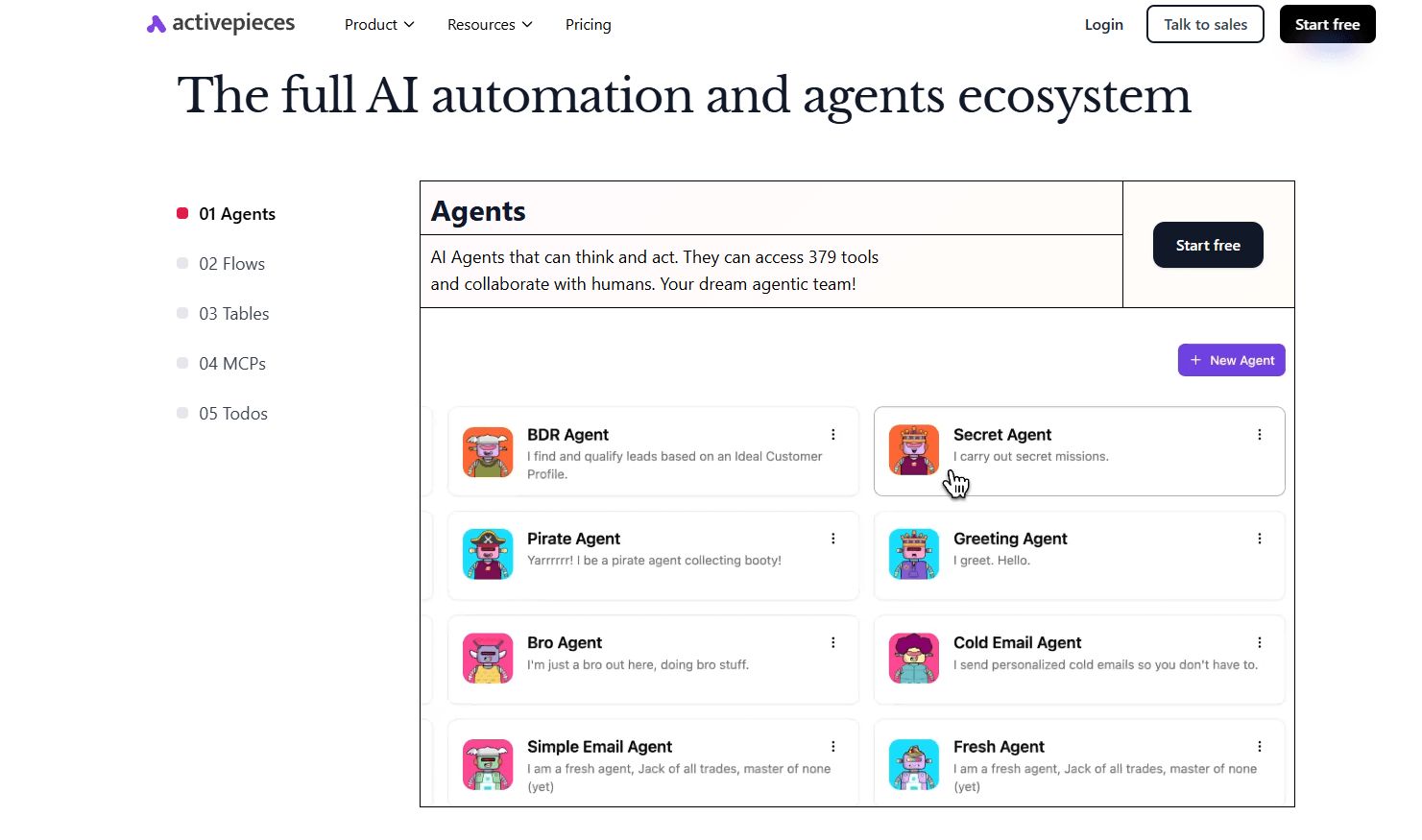How to Automate Manual Processes: Elevate Your Business

Manual work eats up hours that could be better spent elsewhere. Many of these jobs are time-consuming and often push other tasks to the side.
Employees get stuck fixing mistakes or repeating actions that never move the business forward. To get past that cycle, you can follow specific steps that cut wasted effort and improve results.
Companies that implement automation save money and free their people to focus on meaningful work. In this article, you'll learn what manual processes can be automated and how digital workflow automation helps.
Skip task limits and test unlimited automations with Activepieces!
What Does It Mean to Automate Manual Processes?
Manual tasks take time that could be spent on real progress. You get stuck doing the same task over and over, often through manual methods like spreadsheets, emails, or paper forms. Those habits slow everyone down, create human errors, and waste significant time.
An automation process changes that pattern. Work that once depended on people copying data or passing files between departments shifts into systems that run on their own.
For example, a modern ERP system can automate these processes so that information moves smoothly between finance, HR, and operations.
When you move from manual business processes to automated solutions, you cut repetitive tasks and optimize processes.
The Role of AI in Automating Manual Processes
Older automation worked well for predictable steps but broke down when something unexpected came up. Artificial intelligence (AI) removes that limitation by:
- Studying patterns
- Learning from new inputs
- Adjusting on its own
AI reads emails, invoices, or scanned forms without someone retyping the details. It can flag odd data, suggest corrections, and even make choices based on what it has learned from past outcomes. Over weeks and months, the system becomes sharper and more reliable.
Why Activepieces Is the #1 Choice for Manual Process Automation

Activepieces is open-source workflow automation software that supports both developers and everyday business users. It offers a framework where technical teams can customize deeply while non-technical staff design flows without code.
Unlike many competitors that split "basic" and "enterprise" experiences, Activepieces keeps everything under one roof. The platform is community-driven, meaning new integrations and improvements come from both its team and the larger user base.
This approach keeps the library fresh and responsive to modern needs, particularly in AI and SaaS ecosystems.
For companies with strict data policies, the self-hosted edition offers maximum control without sacrificing access to the full catalog of pieces. For those who prefer cloud solutions, tiered pricing keeps costs predictable regardless of task volume.
Key Features
- Open-source framework - Built-in TypeScript gives developers the freedom to create, edit, and share pieces easily.
- No-code builder - Designed for quick flow creation, which allows non-technical users to launch automations with a short learning curve.
- AI-native design - Includes AI steps, agents, and AI Copilot support inside the builder.
- Community-driven growth - Over 60% of integrations are contributed by users, expanding the catalog faster than competitors.
- Human input interfaces - Built-in triggers such as chat and form inputs let teams create flows that involve real-time feedback.
- Secure by design - Options for self-hosting ensure sensitive data never leaves a company's environment.
- Enterprise-ready controls - Branding, approval flows, and advanced permissions allow large teams to work confidently.
Integrations
The platform currently has 425 pre-built connections, or pieces, and the list continues to expand through community input.

Pieces you get include:
- OpenAI
- ElevenLabs
- Airtable
- Google Sheets
- Microsoft Excel 365
- Slack
- Stripe
- Discord
- Zoho Desk
- WooCommerce
- WordPress
- Zoho Invoice
- Microsoft Power BI
By combining open-source contributions with enterprise integrations, Activepieces stays relevant across industries.
Use Cases
Activepieces adapts across departments, letting teams replace routine work with intelligent workflows.
- HR teams can speed up HR processes like onboarding forms, approvals, and payroll updates.
- Sales departments handle lead routing, CRM updates, and timely follow-ups without manual intervention.
- Finance automates financial processes such as invoicing, expense tracking, and reconciliation.
- Customer support uses AI-powered flows to improve response time and overall customer satisfaction.
Across each scenario, automation removes repetitive steps and gives staff space to focus on higher-value decisions.
Pricing
Activepieces offers an open-source Community Edition that's free and self-hosted. Cloud-hosted plans start with a Free plan that includes 1,000 tasks per month, AI agents, and two active flows.
The Plus plan at $25 per month suits small teams with unlimited tasks under fair use, 500 AI credits, and email support. Meanwhile, the Business plan at $150 per month expands to 50 flows, 1,000 AI credits, and five user seats.
Enterprise plans are custom, offering unlimited projects, advanced resources, and dedicated support.

Compared to competitors that charge per task or per operation, Activepieces uses flat-rate pricing, which makes costs predictable and often lower for high-volume users.
Connect with our sales team and find the right plan for your business!
Why Automating Manual Processes Matters in 2025
Relying on manual data entry and similar chores drains time and leaves room for mistakes. Work like that is error-prone, demands more labor hours than necessary, and keeps people stuck in tedious tasks.
Operating a company that way in 2025 puts you at a disadvantage. Leaders now use automation to boost efficiency, cut mistakes, and give employees time for work that adds more value.
The pressure comes from two sides:
- Companies need to accommodate business growth without constantly adding new hires.
- Leaders are looking for cost savings by replacing slow steps with reliable systems.
When the routine work is automated, the same team gets through more projects, deadlines shorten, and the outcome is improved productivity.
Automation also pushes forward real process improvements: data moves smoothly between departments, managers make quicker choices, and customers see consistent service.
Other potential benefits include faster delivery, higher accuracy, and simpler compliance. Companies that adopt these systems stay competitive while those tied to manual methods fall behind.
What Types of Manual Processes Can Be Automated?
Every company faces common tasks that eat up time and pull people away from bigger goals. Embracing automation turns those chores into smooth workflows and helps match each business need with the right system.
Data Entry and Reporting
Typing numbers into spreadsheets or copying them between tools eats up more hours than you realize. That kind of work also invites mistakes, which means someone later has to check and correct the results.
Automating data entry and reporting cuts out those gaps. Reports arrive faster, numbers stay consistent, and trends show up clearly.
Freeing people from this grind ends up allowing employees to focus on planning, analysis, or customer work instead of filling in cells. Leadership benefits too, since dashboards update in real time and provide the information needed for quick choices.
How Activepieces Automates It
With Activepieces, you can connect spreadsheets, CRMs, and communication apps without writing a single line of code. For example:
- Use the "Expense Tracker" flow to automatically log expenses into Google Sheets and generate structured reports.
- Apply "Email Routing" so incoming emails that contain attachments are scanned, then the data is extracted and added directly into a report or database.
- Deploy "Sales Call Transcript Analyzer" to push call notes straight into your CRM, avoiding double entry and missed details.
Customer Support Workflows
Support requests don't stop at five o'clock, and customers expect quick answers. Automation helps by sorting routine tickets for instant replies to common questions and routing complex cases to the right agent.
This balance creates stronger customer satisfaction and a smoother customer experience.
People get answers right away when the issue is simple, and staff are free to deal with urgent issues that need a human touch. Over time, the team feels less pressure, the service feels more consistent, and the whole support function scales without hiring dozens of new people.
How Activepieces Automates It
Activepieces offers ready-to-use flows that route messages, trigger alerts, and push updates into support tools. For example:
- "Email Routing" flow can filter incoming support emails and send them to the right department automatically.
- "Automated Upselling" flow can follow up with customers after a ticket closes, offering upgrades or add-ons based on their request history.
HR Tasks
Human resources carries a load of routine duties:
- Tracking leave
- Managing benefits
- Handling payroll
- Screening applicants
Automation reduces the time spent on those chores. Core HR processes like scheduling or compliance updates run on their own, while staff have space to tackle long-term goals. You get better data for decision-making because the numbers are current and complete.
The shift also eases day-to-day operations, so the company can keep up with demand without straining its limited resources. For workers, the change means faster responses and a smoother overall experience, from onboarding through to offboarding.
How Activepieces Automates It
Activepieces has flows designed for recruitment and employee management. For example, the "CV Screening and Scoring" flow automatically reviews resumes, scores candidates, and forwards the top profiles to HR.
Marketing Tasks

Without automation, your marketing team burns time repeating the same steps every week. Moving those jobs into systems changes the pace.
Emails go out on schedule, leads move through drip campaigns, and social updates post automatically. That frees the team to experiment with new messages and strategy. Performance data arrives quickly, so campaigns can be adjusted on the fly.
The end result is sharper outreach and better use of creative energy. By handling the repetitive side of the work, automation gives marketers the room to focus on the kind of ideas that win attention.
How Activepieces Automates It
Activepieces provides marketing-specific flows to reduce the manual load. For example:
- "Lead Nurturing" flow sends articles or videos automatically to warm prospects to keep them engaged.
- "Lead Appointment Qualification" flow sorts leads based on set criteria and books calls when they're ready.
- "Automatic Scraping of Company Information" flow collects data on prospects before outreach.
Contact sales and find the right plan for your business!
Inventory Management
Running stock with spreadsheets always ends the same way:
- Items go missing
- Orders get delayed
- Customer trust slips
With automated inventory management, every product scan updates the system instantly. A warehouse worker receives goods, scans them in, and the count adjusts across all locations in real time.
This prevents overselling online and alerts managers before shelves run empty.
Purchase orders can trigger automatically once stock falls below set levels, so buyers don't have to watch spreadsheets daily. The system also helps spot slow movers, which lets managers cut storage costs on products that tie up capital.
For businesses that ship thousands of items, automation cuts days off fulfillment cycles and ensures customers get what they ordered without delay.
How Activepieces Automates It
While Activepieces doesn't list a direct "inventory" flow, you can link e-commerce tools, order systems, and spreadsheets to manage stock. For example:
- Connect your ERP system with Google Sheets so inventory levels update instantly when an order is placed.
- Use triggers from Shopify or WooCommerce to send low-stock alerts to Slack or email.
- Automate purchase order creation by linking sales data with supplier records.
Sales and CRM Updates
Sales teams lose hours every week typing notes, updating contacts, and logging calls. A rep, for instance, who spends 15 minutes after every meeting entering details into the CRM. By the end of the week, that's five hours gone.
Automating those updates removes the burden and lowers the risk of missing key information. Calls can be transcribed automatically, emails synced, and contacts updated without manual entry. That context flows into the pipeline so you see real-time progress.
Forecasts then improve because the data is complete, not outdated. Automated lead routing also makes sure new prospects land with the right rep immediately. It even helps reps sell more and enhance the experience for every prospect.
How Activepieces Automates It
Activepieces makes CRM updates hands-free with flows like:
- "Sales Call Transcript Analyzer" that pulls meeting notes into the CRM automatically.
- "Lead Nurturing" flow that logs each touchpoint and makes sure prospects don't go cold.
- "Email Routing" flow that pushes inquiries into CRM pipelines.
Finance and Invoicing
When you create invoices by hand, errors slip in and payments get delayed. Automating financial processes keeps things moving.
For example, when a project closes, an invoice can be generated, sent, and tracked automatically. If a client misses the due date, a reminder goes out without anyone lifting a finger.
Automated reconciliation connects the bank feed directly to the ledger, flagging only exceptions for human review. The result is faster month-end close, cleaner records, and steadier cash flow.
How Activepieces Automates It
With Activepieces, financial tasks can run automatically between apps. For example:
- "Expense Tracker" flow captures expense details from emails or forms and records them in a finance sheet.
- "Email Routing" flow ensures that invoices sent via email are stored and tracked in one place.
Experience Next Level Automated Workflows With Activepieces

Some automated software only handles simple jobs but collapses when teams try to scale. Others bury users in technical setups that slow adoption.
Activepieces removes that tradeoff. Developers get full control with TypeScript while non-technical teams build flows in minutes with the drag-and-drop builder.
Zapier runs only in the cloud and charges by task, which makes costs unpredictable. n8n requires more technical overhead before a company can see value.
Activepieces covers both gaps. It can run in the cloud for ease or self-host for full data control. Pricing stays flat, no matter how many tasks run.
Besides that, the ecosystem grows quickly because the community contributes most of the integrations. That makes it one of the largest open libraries, with new pieces added faster than closed competitors.
Native AI support means flows can use providers like OpenAI or Google Gemini without extra layers.
Enterprises gain security and branding options, while smaller teams benefit from quick setup. Activepieces makes automation scalable, practical, and ready for real business use.
Try Activepieces today and get access to 425 ready-to-use pieces!
FAQs About Automating Manual Processes
How to automate a manual process?
You start by looking at the steps that take the most time or involve mundane tasks. Then you replace those steps with technology that can handle them faster. The aim is to improve efficiency by removing human errors and giving employees more time for higher-value work.
When done right, automation helps organizations achieve more with fewer resources while still keeping accuracy high.
What does it mean to automate processes?
To automate processes means shifting work from people to systems that can complete the same steps without constant oversight. For organizations, this means repetitive tasks are handled by tools that run on rules or AI.
It gives leaders the chance to focus on strategy instead of routine work, helping them manage operations in a way that supports long-term growth.
What is an example of a manual process vs an automated process?
Manual data entry for invoices is a good example. A person types details into a spreadsheet line by line, which is slow and error-prone.
With an automated process, software pulls the data from scanned invoices, validates it, and posts it directly into an ERP system. That single change can save organizations significant time while improving accuracy.
How can I influence the automation of manual processes?
You can influence automation by pointing out where people spend the most time and showing how automation could free them up. Leaders should manage this shift by first making sure the tools fit the business and by first proving the potential benefits with small projects.
By leading these efforts, you help the company adopt automation step by step and build trust in the results.


